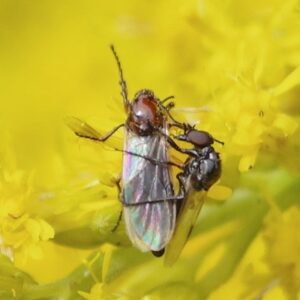Note: All links leave to external sites.
Greetings, BugFans,
The BugLady loves finding species she’s never spotted before – there are many thousands of insects she has yet to photograph, but that’s a matter of “right time; wrong habitat; more road trips.” This year’s new bugs were mostly wasps, flies, and katydids – stay tuned. And, as vintage BugFans know, the combination of the BugLady’s hyperopia (farsightedness) and her camera lenses (first a 50mm macro lens, then a 70, and now a 100mm) lure her into the world of little stuff.
They are in different families, but (besides size), what today’s two flies have in common is a very limited on-line presence.
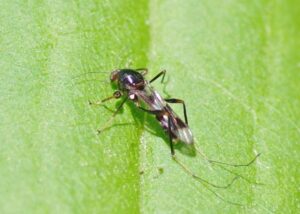
FLY #1 – Heteromyia prattii
People frequently ask the BugLady about the clouds of midges they see dancing in the air, especially at the start and end of the bug season. Those are mostly cold-tolerant species of non-biting midges in the family Chironomidae – fragile, mosquito-y-looking flies with long front legs. When she found this little fly in the brush near a wetland in June – a fly with a husky-looking thorax, bulging front legs, patterned wings, and extraordinary back legs – she was clueless (thanks, as always, PJ).
It’s in the family Ceratopogonidae, the Biting midges (aka Punkies and No-see-ums). Googling No-see-ums results in a flood of Extension and Exterminators sites. Why? Many female Biting midges sip the blood of reptiles, of humans and other mammals, and even of other insects in order to fuel their egg-laying. To this end, their mouthparts are adapted for slicing through skin. Among their targets are humans who are enjoying the outdoors – their bite is painful; the aftermath is irritating; and the lesions may last for weeks if the victim is allergic. To top it off, some Biting midges can be vectors of disease in humans and livestock, here and abroad (none affect humans in North America). Males don’t bite, and both males and females are fond of nectar.
Biting midges are found across the continent and around the world. Their larvae grow up in moist/wet, sheltered spots, and the adults are found in early summer in woodlands and around wetlands, both saltwater and fresh.
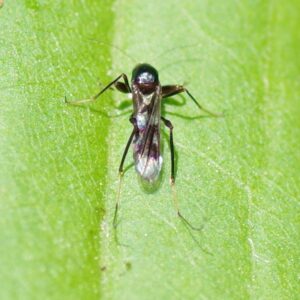
Heteromyia prattii (no common name) is found in the eastern US and into southern Canada, but most of the dozen or so other genus members are tropical. Its larvae live in shallow water and wet edges. Like other Ceratopogonids, the adults are small – about 4mm (¼”-ish). Here are some better pictures than the BugLady managed.
About this species, little has been written, but more is known about its tribe, Heteromyiini. In a paper published in 1978, Wirth and Grogan summarized the natural history of the tribe, going back to early observations of the fly. They wrote “So far as known, the adult females are predaceous on chironomid midges and other smaller, soft-bodied insects,” and they quoted from an 1856 paper “The species whose femora are armed with spines make a prey of other small insects, which they pierce with their sharp proboscis.” A century later, Downes wrote that “The females of insectivorous Ceratopogoninae (typical genera: Ceratopogon, Stilobezzia, Clinohelea, Palpomyia) feed on small insects that are captured in flight. The prey is almost always the male of species of Nematocera and Ephemeroptera, and it is frequently, and probably typically, captured in the male swarms (mating swarms) that are so often produced in these groups. They thus reach, perhaps almost indifferently, the male swarm of their own or another species and proceed to capture prey.” His account included a picture of a female Biting midge eating the male she was copulating with. The larvae feed on invertebrates that are even smaller than they are, newly-hatched midges, and egg masses.
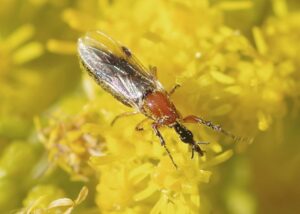
FLY #2 – Dilophus stigmaterus (no common name)
The BugLady noticed Fly #2 when she was hauling her gear up the stairs of the hawk tower in September. A few of the goldenrods at the base of the tower were covered with these speedy little flies, but plants not too far away had none.
They’re in the March fly family Bibionidae, called March flies because many of the species emerge in spring. If you’ve been to Gulf Coast, you’ve probably encountered swarms of March flies called Love bugs, in flagrante delicto (second meaning) (about Love bugs, bugguide.net says that because they became very numerous very abruptly, “There are a number of popular myths about this species, including that it was a lab creation designed to control mosquitoes.”).
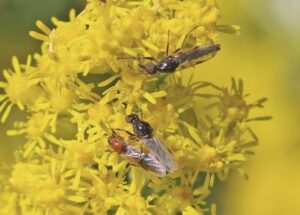
It’s not surprising that the BugLady saw a bunch of these flies. March fly larvae live gregariously on/in the ground and under leaf litter (some are found in compost heaps), eating rotting plants and live plant roots and contributing to soil building. They often emerge as adults synchronously, forming large mating swarms. Females lay their eggs in small holes that they dig in moist soil. The adults’ brief lives are focused on romance. Those species that feed (not all do) eat nectar, pollen, and honeydew, and some March flies are important pollinators, especially of irises and orchids.
Dilophus stigmaterus is sexually dimorphic – males are all black, and females have a reddish thorax, and both have a ring of tiny spines on their front tibias. A long “nose” (rostrum) that is about as long as the antennae, and extended mouthparts that are about three times as long are key characteristics for the species. Curious about how Dilophus stigmaterus lives its life? The BugLady is, too, but other than a very detailed anatomical description of the species written by WL McAtee in 1922, and the fact that they’ve been recorded nectaring on Boneset, she couldn’t find anything else about them. Remember – according to the Smithsonian, there are around 91,000 described species of insects in the US and probably another 73,000 waiting to be discovered/described. While they all do their bit to make the world go ‘round, many do so very unobtrusively.
The BugLady
